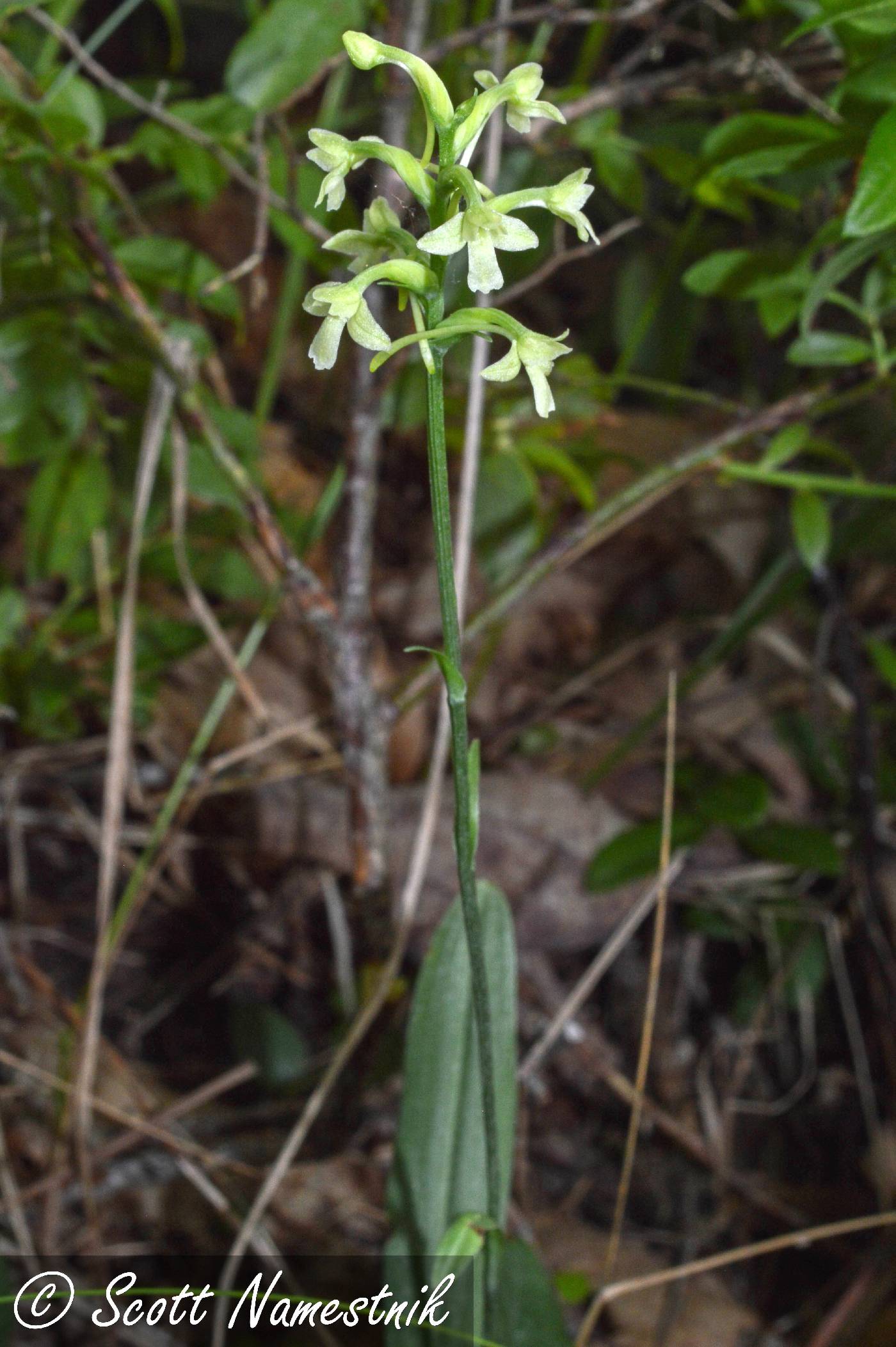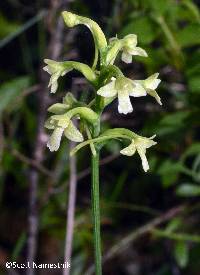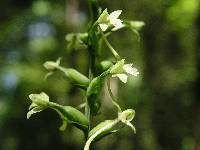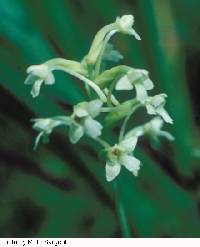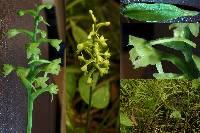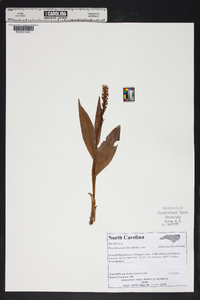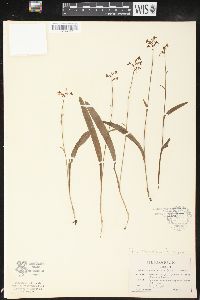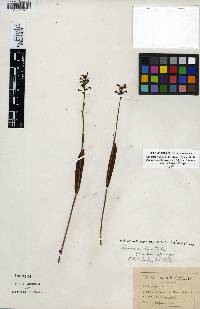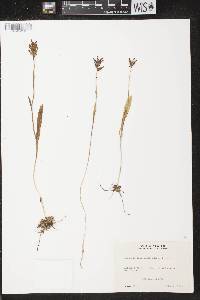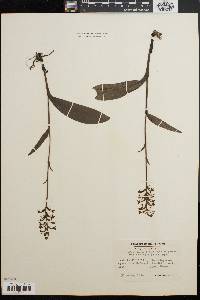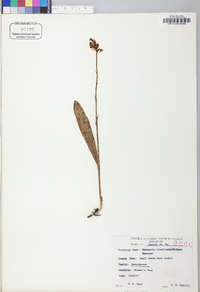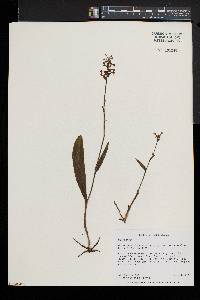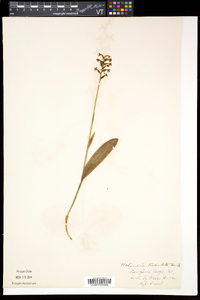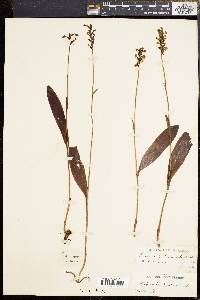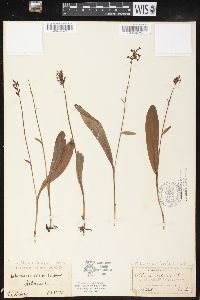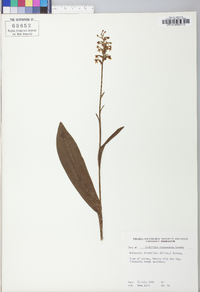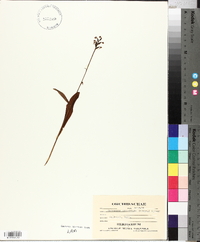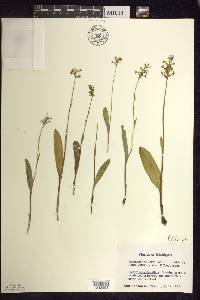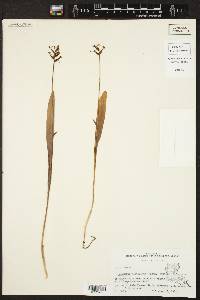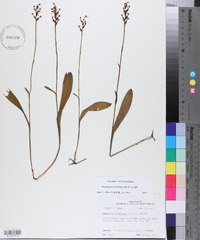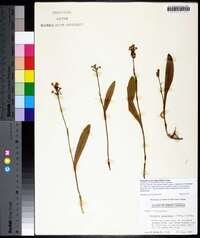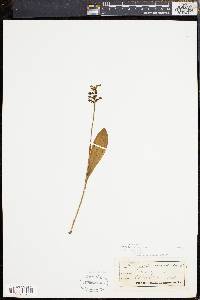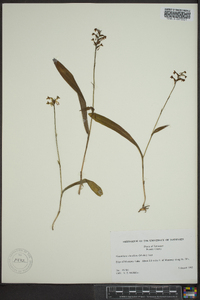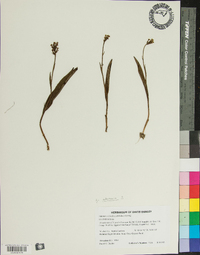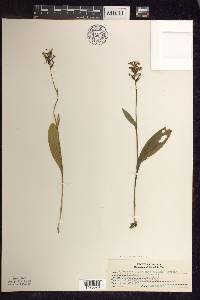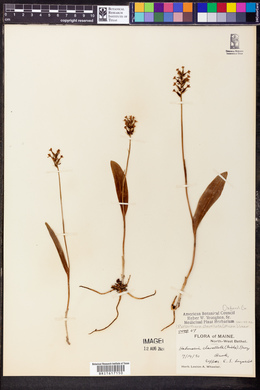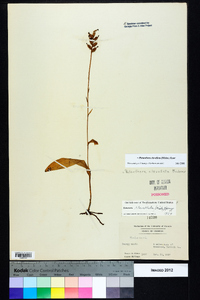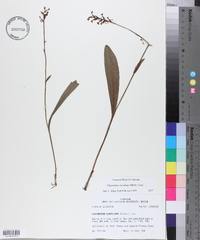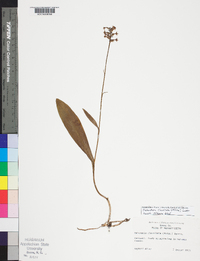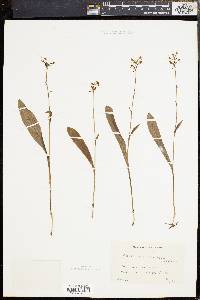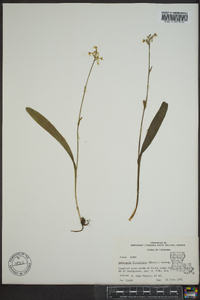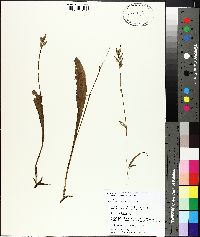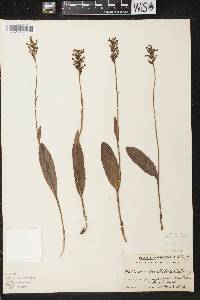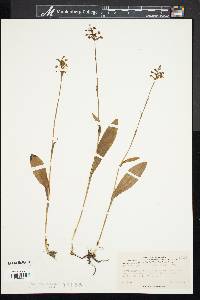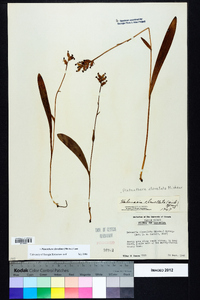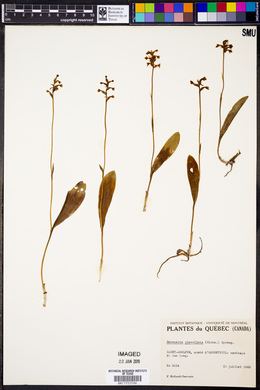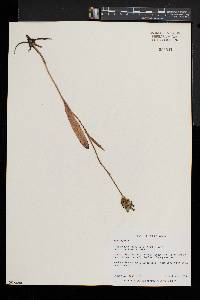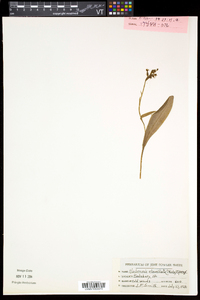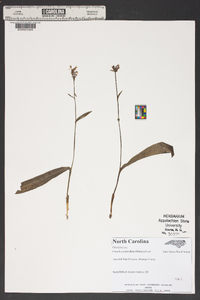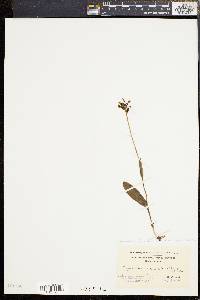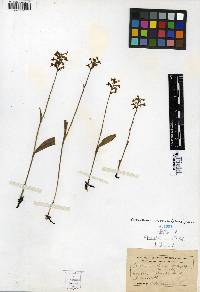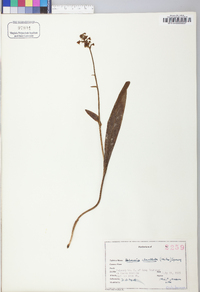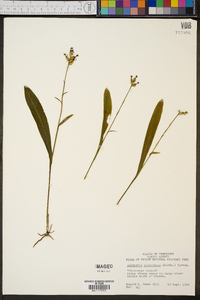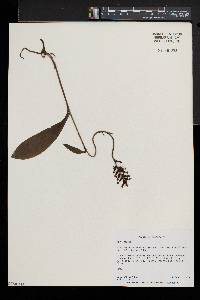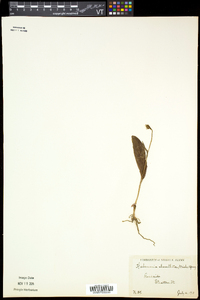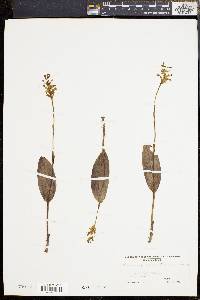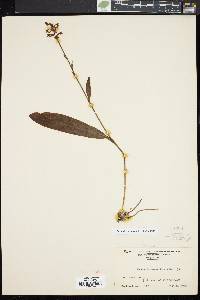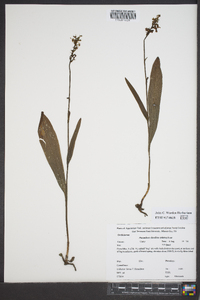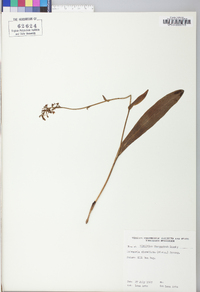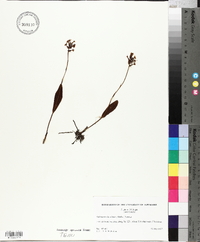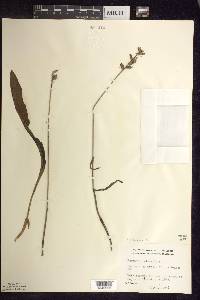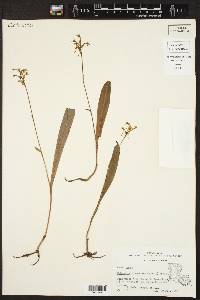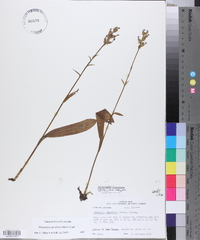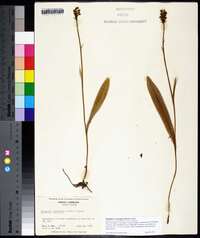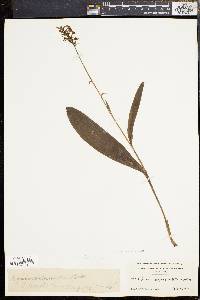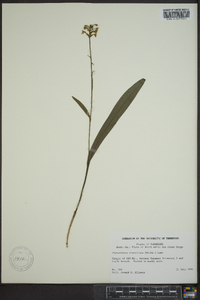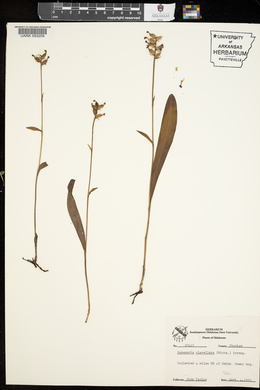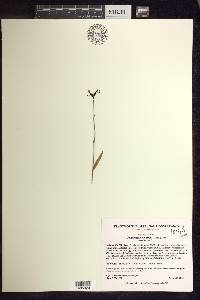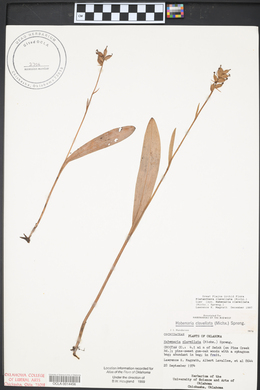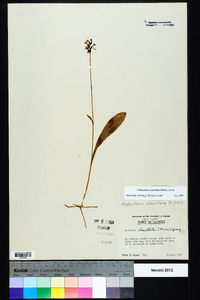Platanthera clavellata
|
|
|
|
Family: Orchidaceae
Green Woodland Orchid, more...small green wood orchid
[Gymnadenia tridentata, moreHabenaria clavellata (Michx.) Spreng., Habenaria clavellata var. clavellata , Habenaria clavellata var. ophioglossoides Fernald, Habenaria clavellata var. wrightii Olive, Habenaria tridentata , Orchis tridentata] |
Plants 8-47 cm. Leaves 1(-2), on basal half of stem, ascending to spreading, usually abruptly reduced to bracts distally; blade oblanceolate to oblong, linear-oblong, or elliptic, 3-19 × 0.8-3.5 cm. Spikes moderately dense. Flowers resupinate, often incompletely so and held at angle, not showy, rather inconspicuous pale green to dull yellowish green; lateral sepals porrect; petals ovate to obovate; lip oblong, obscurely 3-lobed, without basal thickening, 3-7 × 3-4 mm, margins sometimes dentate-lacerate, apex truncate; spur clavate, 7-13 mm; rostellum lobes directed downward, very short, truncate; pollinaria straight or slightly curved laterally; pollinia fragmenting, pollen masses trailing down onto stigma; viscidia linear to linear lanceolate; ovary rather stout, 6-11 mm. 2n = 42. Flowering summer (Jun--Aug). Sphagnum bogs, sphagnous seeps and meadows, wet sandy and peaty meadows, marshes, low woods, wet prairies, and roadsides; 0--2000 m; N.B., Nfld. and Labr. (Nfld.), N.S., Ont., P.E.I., Que.; Ala., Ark., Conn., Del., D.C., Fla., Ga., Ill., Ind., Iowa, Ky., La., Maine, Md., Mass., Mich., Minn., Miss., N.H., N.J., N.Y., N.C., Ohio, Okla., Pa., R.I., S.C., Tenn., Tex., Vt., Va., W.Va., Wis. In common with Platanthera nivea and P. integra, the column of P. clavellata bears a series of lateral projections that are directed forward; the upper pair is elaborately adorned and may be glandular. It appears that this species is inappropriately placed in Platanthera. See note under 30. P. nivea. The broader leaves cited as distinguishing Platanthera clavellata var. ophioglossoides are more prevalent in the North, but occur throughout the range of the species. In some areas populations commonly display a complete range of leaf shape; this feature alone is of no taxonomic significance. The unusual and infrequent hybrid Platanthera blephariglottis × P. clavellata is P. × vossii Case.
Perennial herb 8 - 47 cm tall Stem: single, erect, small, green, hairless, with one, obvious, large leaf below middle of stem, and one to two reduced, linear, pointed, bract-like leaves above. Leaves: two to three, alternate, stalkless, non-toothed, hairless, with lowermost (below middle of stem) largest (5 - 20 cm long, 1 - 4 cm wide), ascending to spreading, oblong to inversely egg-shaped (widest above middle), and upper one or two smaller, linear, pointed, and bract-like. Although the lowest leaf is usually attached just below the middle of the stem, it often appears to be much lower on the stem if the stem arises through thick moss. Inflorescence: a single, erect, terminal, hairless, short, compact, fairly dense, spike-like cluster of seven to ten, almost stalkless flowers with each flower subtended by a 0.3 - 1 cm long, 1 - 1.5 mm wide, lance-shaped, non-toothed, hairless bract. The individual flowers are twisted about forty-five degrees in relation to the inflorescence stalk, such that face-on the lip points to about four- or five-o'clock rather than straight down at six-o'clock. Flowers: very short-talked, twisted off-parallel, pale greenish yellow to whitish, not showy, small, hairless, bilaterally symmetric with spreading lateral sepals, and center sepal and lateral petals closely positioned upward and forward above the blunt lip petal, which has base modified into a very long nectar spur. The reproductive parts of stamens, stigma and style are fused into a column above the stout, 0.6 - 1.1 cm long inferior ovary. Sepals: three, petal-like, pale yellowish green, hairless, non-toothed, 4 - 6 mm long, 2 mm wide, egg-shaped with rounded tips. The two lateral sepals spread outwards on either side of the lip petal, while the central, uppermost sepal is fairly erect, closely positioned with the lateral petals, which together arch over the lip petal and column forming a high hood. Fruit: few, fairly stalkless, ascending, plump, hairless, almost rounded, angled capsules with remnant floral parts at apex, and subtended by very small bracts. Roots: slender, fleshy. Lateral petals: two, closely flanking center sepal, ascending and curving forward or inward at tips, pale greenish yellow to whitish, hairless, 3 - 5 mm long, 2 mm wide, egg-shaped. Lip petal: one, central, lowermost, curved downward past middle, greenish yellow to whitish, hairless, 3 - 7 mm long, 2 - 4 mm wide, oblong, abruptly blunt and shallowly three-toothed along tip. The base of the lip petal is modified into a backward descending, 0.7 - 1.3 cm long, yellowish green, club-shaped spur. Similar species: Platanthera clavellata is most similar to P. flava var. herbiola, but that species has at least two conspicuously large leaves with the remaining leaves obviously reduced to bracts, the floral bracts are longer (especially in lower half of inflorescence where they obviously exceed the flowers in length), the lip petal has two small tooth-like projections on each side at the base and then a prominent bump at the middle of the lip before it flexes sharply downward, and the spur is typically shorter (under 1 cm long). Flowering: July and August Habitat and ecology: Rare in our area, typically in sphagnum or other moss on hummocks or fallen and rotting logs in borders of bogs or mesophytic swamps, moist peaty sand prairies, organic sandy borders of vernal pools, and sandy peaty swale borders. Occurence in the Chicago region: native Notes: Though one of the more common wetland orchids, P. clavellata is among the smallest and least colorful. Some sources have distinguished individuals with broader leaves as P. clavellata var. ophioglossoides, but due to the great variety and continuity of leaf shapes and sizes across its range, these features do not merit any separation at a taxonomic level (Sheviak 2002). Etymology: Platanthera comes from the Greek words platys, meaning flat or broad, and anthera, meaning anther, which refers to the wide anther of the genus. Clavellata means "small club", thus referring to the club-shaped spur of the flower. Author: The Field Museum Slender, 1-4 dm; foliage lf 1, near or just below (seldom well below) the middle of the stem, linear-oblong to narrowly elliptic or oblanceolate, 7-16 cm, up to 3 cm wide; upper lvs 1-few, much reduced; infl open, 2-6 cm, the narrowly lanceolate bracts shorter than the 5-15 fls; fls divergent, white or tinged with green or yellow, twisted to one side so that the spur is lateral; lip broadly cuneate, 3-5 mm, shallowly (sometimes obscurely) 3-lobed at the summit; sep and lateral pet broadly ovate, 4-5 mm; spur 7-12 mm, strongly curved, dilated at the tip; 2n=42. Acid bogs and wet soils, especially in sphagnum; Nf. to Ont. and Minn., s. to Fla. and Tex. June-Aug. (Platanthera c.) Gleason, Henry A. & Cronquist, Arthur J. 1991. Manual of vascular plants of northeastern United States and adjacent Canada. lxxv + 910 pp. ©The New York Botanical Garden. All rights reserved. Used by permission. From Flora of Indiana (1940) by Charles C. Deam My specimens are from moist, sandy or gravelly borders of lakes and sloughs. The distribution is restricted to our northern counties with the exception of a specimen collected in a swamp in Monroe County by J. E. Potzger. There is a report from St. Joseph County which is not shown on the map. …… Indiana Coefficient of Conservatism: C = 9 Wetland Indicator Status: OBL |

